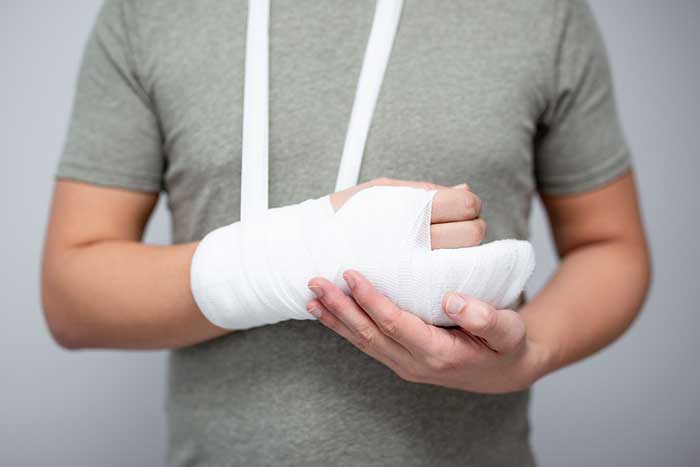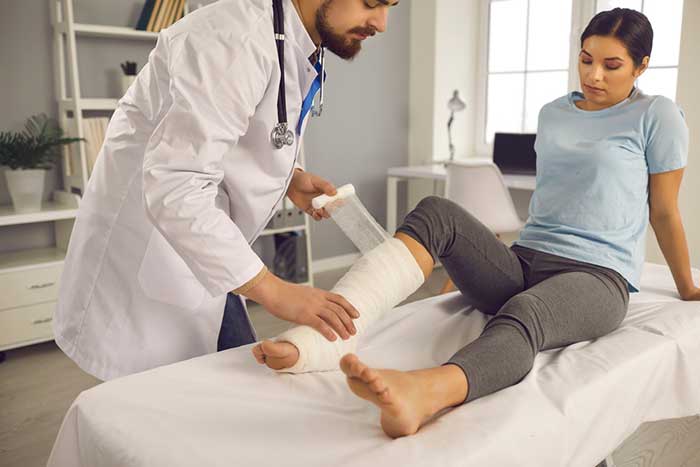Anyone who’s ever broken a bone will tell you how much it hurts. Dislocated joints are no different too. Both are painful injuries often caused by accidents at work or at play. Usually, they result from trauma from a heavy impact, like a fall or a collision. They’re also relatively easy to treat if you’re calm and know what you’re doing.

There are differences between fractures from dislocations. The former is a broken bone, while the latter is a bone that has slipped out of the joint. However, both show similar symptoms, which include:
- Pain
- Swelling or bruising
- Discoloration
- Mobility limits
- Deformity of the area
- Numbness or tingling sensation
First aid techniques for both injuries are also quite similar. Read these tips to apply them if you encounter someone who has accidentally broken a bone or dislocated a joint.
1) Follow The DRSABCD Plan
When you see an accident, you have a limited time frame to take action. Panicking is the first instinct of many people untrained in first aid or have never seen an accident up close. While you may not have any experience treating something as severe as bone fractures, you can still prepare for such an event.
Stock up on high-quality emergency tools like splints, slings, and tourniquets you can stash in a bag or keep in a first aid kit. You can check this additional info for other equipment you might need to treat common injuries caused by accidents. Another thing you can do is to memorize the DRSABCD plan. These letters stand for the following steps:
- Danger: Observe and ensure that the area you or the patient are in is safe.
- Response: Ask for the patient’s name and squeeze their shoulders gently for their response. If they respond, make them comfortable and check them for additional injuries. If they don’t have any, proceed to the next step.
- Send for help: Immediately contact your local emergency hotline for an ambulance. You may also ask someone else nearby to make the call.
- Airway: If the patient has foreign material in their airways, put them in the recovery position, assuming they don’t have severe injuries on their arms or legs. Turn them to their side and place their free hand under their chin for support. Lift their free leg upwards to prevent them from rolling, then dislodge the foreign object using your fingers.
- Breathing: Listen, look, and feel the patient’s breathing. You may monitor them and manage their injuries if their breathing is stable. If gasping or not breathing, begin CPR.
- CPR: Position your hands at the center of your chest and push hard and fast, preferably twice per second. Do 2 rescue breaths after every 30 compressions. Repeat until medical help arrives or until the patient recovers.
- Defibrillation: If available and needed, apply the defibrillator and follow its voice prompts.
In a best-case scenario, you wouldn’t have to perform all these steps, especially when the patient is conscious, breathing, and aware enough to respond to you. You may proceed with the next step when you know where the fracture or dislocation is.
2) Stop The Bleeding
Depending on the injury’s severity, there may be visible hemorrhaging. There are different types of bleeding from accidents that you can either treat yourself or seek immediate medical aid for. Dislocations rarely bleed out, but traumatic ones may tear muscle tissues and start bleeding internally. Fractures may pierce through the skin, causing an open wound.
If this is the case, apply pressure to stop the bleeding using a sterile bandage. You may also use clean fabric or clothing if the dressing is unavailable. Wrap the cloth around the wound securely.
3) Immobilize The Affected Area
You must lessen the movement of the fractured or dislocated area to avoid additional complications. If you’re trained in first aid, carefully apply a splint on the spot to restrict its mobility. You can use any of the following items as a makeshift splint.
- Rolled-up newspaper or towel
- Wooden plank or board
- Heavy stick
In the case of neck or back fractures, avoid moving or touching the area until help arrives. Don’t pop or push dislocated joints back into their socket. You could cause more damage to it, especially if there’s a torn muscle. Leave it as is for now.
4) Apply An Ice Pack
If ice cubes are available, make a cold compress using a clean cloth or towel, and apply it to the injury to reduce pain and swelling. You can also use gel-type ice packs to wrap around the affected limbs easily. Avoid applying the ice cubes directly to the skin.
5) Encourage The Patient To Relax

The shock and trauma from an accident can make any patient panic, which may add further damage to their injuries. Try to put them in a comfortable position without moving the fractured or dislocated part too much. You can talk to them to reassure them that everything will be fine. If they feel cold, cover them with a blanket or extra layers of clothing to keep them warm.
If the patient feels faint or is short of breath, carefully lay them down with their head slightly lower than their torso. Elevate their legs, if possible, to encourage blood flow to the brain.
6) Additional Note
Many fractures and dislocations, unfortunately, can happen in the workplace. If the patient got injured at work, advise them to act as soon as possible to receive compensation after an occupational injury. They have the right to protect themselves from the implications and costs of getting injured on the job. Let them consult a workplace injury attorney so that they can focus on recovering physically and emotionally.
Conclusion
With a clear head and prompt action, you can perform first aid to a patient who has a fracture or a dislocation. It can be stressful, as any accident is, but if you remember these steps, you could potentially save someone’s life.
